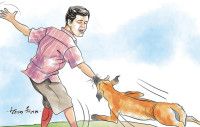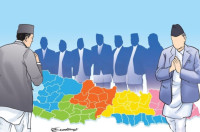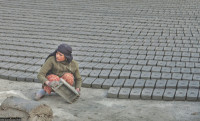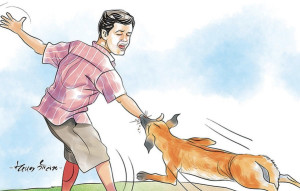Columns
The reality of land rights politics
Ownership of land will give Madheshi Dalits a sense of self-respect.
Chandrakishore
The federal government had introduced an ordinance to ‘address land-related issues’, which faced opposition. Again, a bill has been tabled in parliament. This time too, Madhesh has been stirred. The debate over land, its ownership, relationships and reforms are not new in Madhesh.
Land issues are an ideological and political question. In Madhesh, the largest population of landless people are Madheshi Dalits. Commissions have been formed to address the issues of sukumbasi and unorganised settlers, but the problem of landlessness in Madhesh persists. For Madheshi Dalits, land must be understood in the context of development, poverty alleviation and livelihood. The leadership of the land rights movement in Madhesh has not been in the hands of Madheshi Dalits, even though the slogan of land rights echoes loudest in this region. Land rights activists rarely engage in self-reflection on this matter.
Some Dalit leaders feel that the issue and movement for land rights have been hijacked. Providing land alone won’t solve the problems of Madheshi Dalits, but ownership of land will give them a sense of self-respect. In the name of providing land to the landless, vote-bank politics is being played. Meanwhile, those exploiting public property continue to receive political support. On the other hand, the Madheshi Dalit, long suppressed by inequality, remains in the same distressed mindset, and neither the state nor political leadership seem to grasp this reality.
In the name of land rights, a symbolic figure is often chosen and used in various protests, but the problems of Madheshi Dalits remain unchanged. The reason for repeatedly mentioning Madheshi Dalits is that their issues are unique and distinct. Why have Madheshi Dalits not received land justice to this day? Why does the number of sukumbasi and unorganised settlers in Madhesh keep rising? Landlessness and Madheshi Dalits seem almost synonymous. Due to landlessness, Dalits lag in social, economic and political terms. They are forced to live in risk-prone places. A community that direly needs land, power and authority are the one deprived of it. Living on others’ land, ailani (unregistered public land), or alongside riverbanks and roadsides, many people are compelled to cram into very little space. The land rights movement must be viewed from the perspective of Madhesh itself.
Questions worth pondering: Why does Madhesh get rattled by government steps regarding land? Why does Madhesh feel this is another trap? Why hasn’t trust been built between the state and Madhesh? Why does Madhesh always end up at the same crossroad? Why is this seen as a ploy to expand the base of a particular political force? Who has hijacked Nepal’s land rights movement? Political forces in Madhesh should honestly introspect on this, but such efforts are nowhere to be seen.
There’s no doubt that Madhesh has a landless problem. But the noise is often limited to artificial landless people. The real dharti-santati (children of the soil) remain untouched by this discourse. The slogan of land rights has often been used to strengthen colonial social relations. Those who deserve ownership and reform are the ones left deprived. The real landless in Madhesh always carry great suspicion and fear. Thus, the politics of land is no less intriguing.
Sayings like “Madhesh ko ban, pahadiyaharu ko dhan” (Madhesh’s forests, the wealth of hill people) and “Madhesh ko bhumi, lootna aaunchha ghumi-ghumi” (Madhesh’s land, looted turn by turn) keep resurfacing. Government initiatives for land distribution are seen as a tool of internal colonialism, where the governed are generally excluded from this great political game. Despite changing systems, the ruling groups employ various tactics. The tradition of using Madhesh’s forests, land and manpower for the benefit of a specific community has not been halted by any political change. Such a perception at the grassroots level exists, and it is like embers smouldering beneath ashes.
Who produces the narrative of land rights? Who does this narrative empower? Since the land issue is tied to political, social and economic dimensions, the relationship between the state and Madhesh will remain cold until it addresses the real stakeholders. The unequal distribution of natural resources has been a root cause of conflict in Madhesh. For various reasons, the country has not been fully integrated in all aspects to this day.
Government efforts on land issues are often perceived as reminiscent of Panchayat-era resettlement schemes, seen as a way to legitimise land encroachment. There’s suspicion in Madhesh that forest areas will face deforestation, Chure will be further exploited, and public land will be further encroached upon. There’s concern that land mafias will gain political favour. This has turned land from a natural resource and means of production into a gambling game of encroachment backed by political protection, altering the very meaning and importance of land and land ownership.
Madhesh is confronted with a grave landless situation and public land encroachment. Practices like meter-byaaj (exploitative lending) emerge from the mindset of land domination. There exists a land-based exploitation that has been socially legitimised as a notion of prestige. It becomes fodder for competing political gain and social exploitation, thereby fostering injustice and conflict. Hence, these invisible power relations emerging from ownership of land still continue. Until these power relations emanating from land are addressed in Madhesh, the cycle of inequality will keep producing further forms of oppression. The politics for clearing forests, settling people, and turning them into vote banks will continue.
To make Madhesh feel the essence of federalism at the grassroots, land management is essential. This is a matter of justice delivery. The core issue is ending the exclusion of Madhesh’s true landlessness and establishing respect for impoverished Dalits. In this sense, the land agenda must be understood in a broader context. Madhesh is undoubtedly a stakeholder in the land issue, concerning communities like Santhal, Rajbanshi, Madheshi Dalit, Tharu and Muslim. However, if the problem isn’t resolved, the ongoing conflict could engulf not just these communities but the entire nation.
Why did someone become landless in their own homeland? Who grabbed the land? Why were some displaced? How did someone become a helpless kamaiya or haruwa-charuwa (bonded labourer) in their own land? Even during state-sponsored land distribution in Tarai, how were Madheshi Dalits kept excluded? From Madhesh’s perspective, the land issue is diverse and multifaceted. After moving to provincial governance, there was hope for serious work on this, but it hasn’t happened.
No political force seeking space in Madhesh seems serious about this. Madheshi Dalits are trapped in the labyrinth of local landowners. As long as landowners dominate political parties, the politics of land rights in Madhesh will continue to tread a crooked path. Alongside landlessness, Madhesh grapples with issues like citizenship, unorganised settlements, disaster risks, water crises, wage freedom and identity protection. The dispossession of land from Madhesh’s indigenous inhabitants is an injustice and exploitation that must become an integral part of the land rights politics narrative. Only then will communities, including Santhal, Rajbanshi, Uraon, Tharu, etc., feel a sense of affinity in the land rights movement.




 9.12°C Kathmandu
9.12°C Kathmandu















